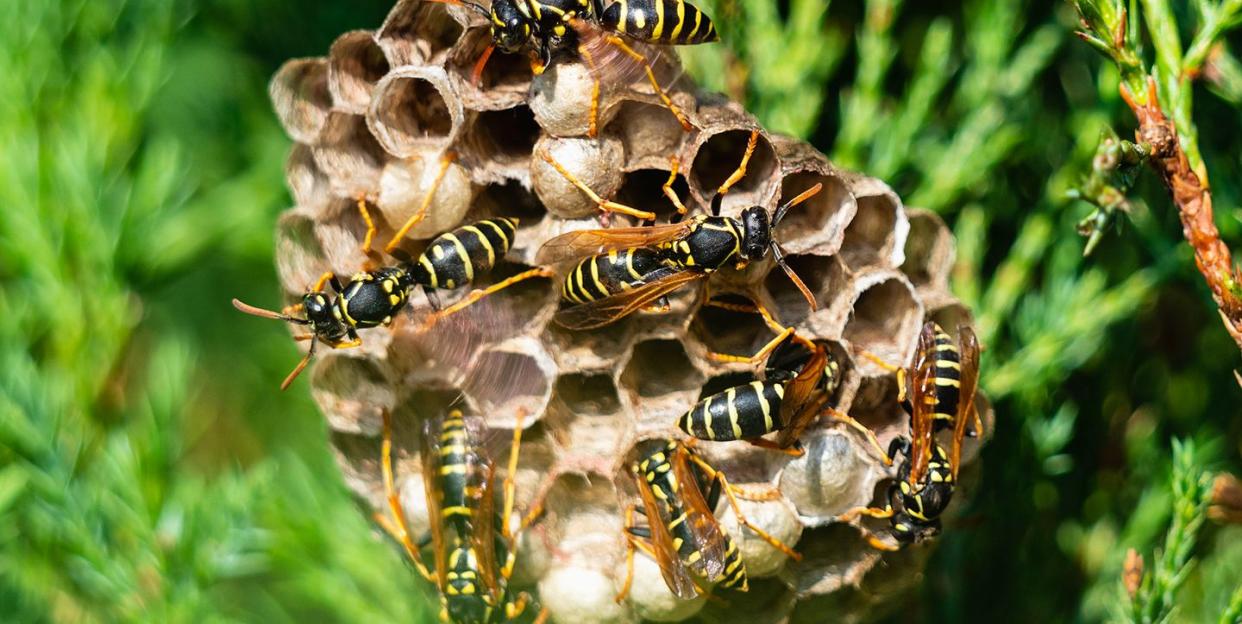How To Get Rid of Wasps and Yellow Jackets

Once warm weather arrives, you'll also find that a familiar, persistent buzzing and zipping sound returns to your yard. The bugs are back, and that includes the stinging varieties. All it takes is a single sting to develop a healthy respect for hornets, wasps, and yellow jackets. So keeping your outdoor spaces free of stinging insects and available for safe play is a priority.
Read on for tips on how to rid your yard of wasps and hornets, and check out our guides for the best bug sprays and bug zappers to help with other home and yard pests you might be fighting off this summer.
What’s the difference between a wasp, hornet, and yellow jacket?
While often confused, they do vary in a few ways. The first is size: Wasps are smaller, while hornets are larger (at about one to one-and-a-half inches long). Unlike bees, which are important pollinators (find out the best flowering plants to attract bees here!), wasps and hornets are carnivorous; they prey on smaller insects like aphids and houseflies (so they are beneficial in their own way). Wasps love your sugary drinks and may hover over your picnic pickings hoping for a taste.
While it's possible to get rid of wasps, hornets, and yellow jackets on your own, remember that they can be dangerous, especially in large numbers, so if you're in doubt, it's best to call a professional to help. Of course, if you are allergic to wasp or bee stings, you need to take precautions and seek outside help. If you feel confident handling your situation, read on for tips that can help with removal.
How to get rid of wasps
First off: Don’t swat at them! Swatting at a wasp tells it to release pheromones that will trigger other nearby wasps to perceive you as a threat, exactly what you don’t want to happen.
If you’re working ahead and trying to prevent a nest from forming, you can try putting up a fake nest to deter a real one from forming (wasps are territorial). If you already have a nest that you need to be rid of, you first need to evaluate the size of the nest. Is it small (just a few to a dozen cells)? If so, you can suit up (long sleeves, pants tucked into your socks, a head net, gloves) and knock the nest down during the coolest time of day and destroy it. If it’s larger, set up multiple wasp traps a good distance away from your home, and follow the instructions on the trap.
Or you can take a DIY approach and make your own trap by cutting a two-liter plastic bottle in two above the label. Take the cap off the top of the bottle. Place bait—fruit juice, canned cat food, raw meat, overripe fruit, etc.—in the bottom of the bottle. Turn the top of the bottle upside-down and place it inside the bottom portion of the bottle. Tape the edges together. Place the trap away from your home (say, 20 feet away). Once it’s full, freeze it to kill the contents, which you can compost afterward.
If your wasp nest is in an area of your property where it isn’t a risk and you won’t disturb it, you can opt to leave it be. Just be sure to keep your yard clean of fruit or garbage, which could draw them closer to your home.
How to get rid of yellow jackets
Yellow jackets can build their nests both above and below ground, making them especially pesky pests. You’ll want to hire a professional if you’re dealing with a large nest or one underground (don't pour anything into it! You could contaminate your ground water). Smaller yellow jacket nests can be removed with the following method:
Don protective clothing as described above when dealing with wasps.
Working during the coolest part of the day, spray the nest with a wasp killer from a safe distance.
Wait a day or two so that yellow jackets coming and going from the nest will have ample opportunity to come into contact with the poison.
You can remove and discard of the nest once you don’t spot any further activity.
You Might Also Like
